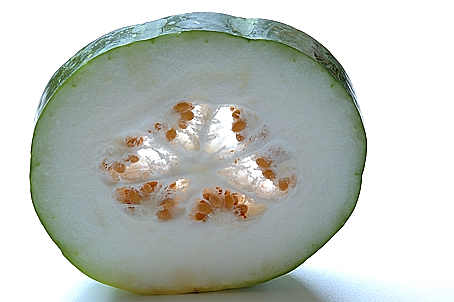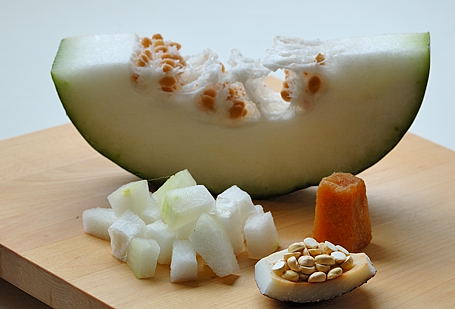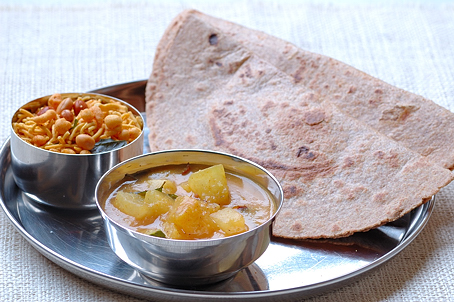(Pumpkin Subzi with Winter Melon from Nandyala)
|
Photo Purchase Keywords: Pumpkin, Subzi (It takes money, time, effort and energy for food photography. Please don’t photosteal. Click on the links and purchase the photos legally to digital download and to print. Thanks.) |

Pumpkin kura sweetened with jaggery is a Sankranthi tradition at Nandyala and in many parts of Andhra, Bharath. Pumpkin is a winter vegetable, and jaggery is made fresh from sugarcane during this season. So on Bhogi, the first day of three day festival Sankranthi, we cook these two together as part of harvest celebration. The pumpkin cubes coated with jaggery-spice mixture glisten like an early morning Sunshine on wintry day in this curry. Usually we serve it with Sajja Rotte (Millet Roti) on Bhogi.
The white fleshed pumpkin is called boodida gummadi in Telugu. Here in US, it is sold as ash gourd or winter melon, often cut into small portions like shown in the image. Winter melon tastes like cucumber, mildly sweet and no smell whatsoever. If this variety is available in your area, do try this recipe. Sweet, aromatic and with ruchi, this curry is a hearwarming wintry delight and a must try for winter-melon fans.

Winter Melon, Coconut, Dalia and Jaggery
Recipe:
(for two, for two meals with roti)
Boodida Gummadi (Winter melon): Peel the skin, remove the seeds and cut the white part to bite-sized cubes : 4 cups
Jaggery-spice Paste:
Dalia (putnala pappulu, Bhuna Chana) – quarter cup
Jaggery, crushed to small pieces – 3 tablespoons
Coconut, fresh or dry, grated – 1 tablespoon
Dried red chilli – 4
Coriander seeds – half teaspoon
Take them all in a mixer, blend to fine consistency.
Kura Preparation:
In a pot, heat a teaspoon of peanut oil. Add and toast a sprig of curry leaves, pinch of cumin and mustard seeds. When mustard seeds start to pop, add the pumpkin cubes. Also the jaggery-spice paste along with a glass of water. Mix. Stir in a pinch of turmeric, and salt to taste. Mix, and simmer, covered for about 15 to 20 minutes, until the pumpkin pieces cook to tender.
Serve the teepi gummadi kura with chapati, sorghum roti or sajja roti. (This curry is not that good with rice.)

Teepi Gummadi Kura with Roti, and Boondhi Mixture
Recipe Source: Amma, Nandyala
This kura is also prepared with orange pumpkin. The recipe is same except the change in pumpkin.
Kura=Curry, Teepi=Sweet, Gummadi=Pumpkin, Ruchi=Flavor (from Telugu to English)

great recipe. Mouthwatering. My mom use to make it with orange pumpkin.
Comment by chandana — January 9, 2008 @ 2:46 pm
The recipe looks so uniquely delicious. Is there any substitute for winter melon for this curry? Thanks for sharing.
Comment by Meera — January 9, 2008 @ 4:15 pm
One question Indira.
You say this Teepi Gummadi Kura doesn’t go well with rice then how come this kura is made on Sankranthi day in Andhra?? I know that they make Bobbatalu, but not roti.
Just curious.
– Anjali
Comment by Anjali — January 9, 2008 @ 5:05 pm
Hi Chandana: Yes, orange fleshed pumpkin also tastes good in this recipe.
Hi Meera: I often make this same recipe with Sorakaya (bottle gourd) and Cho-ch (chayote). They both taste good with dalia-jaggery.
Hi Anjali: Makara Sankranthi is a three day festival in Andhra. Each day has it’s own name. Bhogi, Sankranthi and Kanuma.
On the first day called Bhogi, it’s a tradition for us to prepare this teepi gummadi kura with Sajje roti (millet roti). For Sankranthi, the grand feast day, the rice plays an important part. All kinds of rice treats like pongal, sweet pongal, murmura laddu etc are prepared. And, in some homes bobbatlu etc are also prepared, depends on how good the harvest is that year.
Comment by Indira — January 9, 2008 @ 5:49 pm
Hi Indira,
Ash gourd is one of my very favorites! I’ll definitely try this treat you’ve made. Love the photo of the whole slice 🙂
Comment by Linda — January 9, 2008 @ 6:45 pm
Hi Indira:
This preparation has some interesting parallels with the sambar like preparation “Pitlai” in Tamil Brahmin (just to identify..no discriminaion implied) homes we use kadala paruppu not dalia and traditionalists eschew jaggery..also tamarind is added.
Also my Ayurvedic Vaidya says that white pumpkin is a nervine tonic..very good for memory etc.He asks us to eat more of it during exam times. something to do with the Potassium in it I think?
Comment by Janani — January 9, 2008 @ 7:02 pm
Lovely dish. This is called “Vellai poosani” in tamil and amma makes a sambhar with green chillies (without sambar powder) and that goes well with the pongal. This dish looks very inviting. will try it out soon.
Comment by Nirmala — January 9, 2008 @ 9:33 pm
Hi Indira, Certainly a recipe I am going to try soon as I have half an orange pumpkin which I have to use soon. Something similar is made in Uttar Pradesh with ripe orange pumpkin sans the coconut and bhuna chana and with the addition of amchur powder.
My first comment on your blog though I have been a visitor for ages now. Wanted to email you, please let me know if it is ok. There are tons of your recipes which I have tried and got to know some authentic Andhra recipes. Thank You.
Comment by Nidhi — January 9, 2008 @ 10:10 pm
Hi Indira, We too celebrate 3 day Pongal in Karnataka. Over years it has come to 1 day, however few of the north karnataka districts still celebrate bhogi. Sajja rotti, Jonna rotti, stuffed brinjal curry, chutney powders (esp gurellu podi), peanut podi is sold in stores. It used to be so convinient to celebrate Bhogi when we stayed in India. I make jonna rotti here in Singapore and next time will remember this curry for jonna rotti. Btw I am making ragi idlis today, took the recipe from your blog.
Comment by Lakshmi — January 9, 2008 @ 10:55 pm
hi Indira,Lovely dish.orange fleshed pumpkin also tastes good in this recipe.
Comment by bablu — January 10, 2008 @ 12:14 am
Hi Indira! very nice recipe. My mom used to tell that gummadi kaya tho kura chestharu ani. But I don’t remember me tasting it. Your’s look so tempting, I want to try it right away, if I get this budida gummadikaya. As always, pic is wonderful and happy sankranthi to you and your family Indira.
Comment by Madhavi — January 10, 2008 @ 1:41 am
You do come out with wonderful dishes
Comment by Happy Cook — January 10, 2008 @ 5:39 am
Yes Indira, my grandma makes this curry, but only one variation she cooks like stirfry( talimpu ) instead of stew or pulusu.. Love your version tooo…
Comment by Kalva — January 10, 2008 @ 5:55 am
This is an easy recipe. Tried ur chana baigan. loved it. Both my hubby and i relished it a lot.
Comment by vimmi — January 10, 2008 @ 9:10 am
Linda: Winter melon has become my favorite too in recent months. Also, the local Vietnamese grocery store sell small and already cut portions, perfect for us for one or two meals.
Hi Janani: I like Pitlai. Tuvar dal, vegetables and fresh coconut masala and then tadka right?
Now that you mention it, I remember my mother pleading us to eat pumpkin for brain power, when we were children. I don’t know why, but I used to run away from it. Thank God that one’s taste grow with age.:)
Vellai Poosani sounds good Nirmala. I’m actually looking for new recipes with pumpkin. I’d love to try Amma’a recipe at home.
Nidhi: Thank you for your good words. It would be my pleasure, please write me.
Lakshmi: I think Nandyala and nearby villages and North Karnataka share many traditions. We also cook all the things you have mentioned on bhogi day.
Jananai’s ragi idly is a nutritious recipe. Did you sprout ragi?
Give it a try with this white colored winter melon, Madhavi. Indian stores also carry the small cut pieces during this season. Shubha Sankranthi!
Thanks for your nice notes, HC, Kalva and Vimmi.
Comment by Indira — January 10, 2008 @ 4:30 pm
Hi Indira, Tried Ragi Idlis Yesterday. Lovely it was. I did not sprout ragi, instead used ragi flour available from stores. I made tomato onion sambhar which went well with it. I will blog over the weekend. Thanks to you and Janani for sharing such a healthy recipe. 😀 Have a good day.
Comment by Lakshmi — January 10, 2008 @ 7:21 pm
Love this gumadi kai preparation Indira…Happy Pongal to you.
Comment by Rina — January 11, 2008 @ 7:37 am
yup Indira..exactly right.
Lakshmi: glad to hear your ragi idli venture was successful:)
Comment by Janani — January 11, 2008 @ 12:05 pm
hi indira. i never made curry with budida gummadi kaya.as a child i grew up with these in my garden. my mom always made halwa with this. tastes delicous! its a little tough to grate because of its watery flesh.but try making it. u’ll love it.
i always see these pieces int eh indian store and couldnt dare to buy and make the halwa. but yesterday i bought it just to try ur curry. i didnt have putnala pappu so i added peanuts instead. turned out well.i also added tamarind.now i can buy and make it often!
Hi Srividya,
Yes, budida gummadi halwa and also vadiyalu, I like them a lot.
Happy to read that you tried and liked this recipe. Your version with peanuts is good, I’ll try it for my next try.
-Indira
Comment by srividya — February 19, 2008 @ 3:25 pm